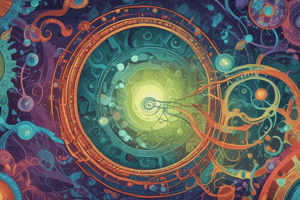Podcast
Questions and Answers
Which of the following is a type of bacterial reproduction mechanism?
Which of the following is a type of bacterial reproduction mechanism?
Bacteria can reproduce sexually.
Bacteria can reproduce sexually.
What are the two main types of viruses based on their genetic material?
What are the two main types of viruses based on their genetic material?
Match the following viruses with their specific characteristics:
Match the following viruses with their specific characteristics:
The bacterium Mycobacterium tuberculosis is known for being an __________ bacterium that causes tuberculosis.
The bacterium Mycobacterium tuberculosis is known for being an __________ bacterium that causes tuberculosis.
What are the three main stages of the viral replication cycle?
What are the three main stages of the viral replication cycle?
Which of the following structures is a component of a virus?
Which of the following structures is a component of a virus?
Name one method of asexual reproduction in fungi.
Name one method of asexual reproduction in fungi.
Viruses can replicate independently outside a host cell.
Viruses can replicate independently outside a host cell.
Match the type of fungi with their examples:
Match the type of fungi with their examples:
What is the primary mode of bacterial reproduction?
What is the primary mode of bacterial reproduction?
Fungi can photosynthesize to obtain their nutrients.
Fungi can photosynthesize to obtain their nutrients.
What component is the cell wall of fungi primarily made of?
What component is the cell wall of fungi primarily made of?
The process of two hyphae of opposite mating types fusing together is known as ______.
The process of two hyphae of opposite mating types fusing together is known as ______.
Which of the following is a characteristic of protozoans?
Which of the following is a characteristic of protozoans?
Fungi can exhibit dimorphism, changing from yeast to mold based on environmental conditions.
Fungi can exhibit dimorphism, changing from yeast to mold based on environmental conditions.
What is the shape of bacilli bacteria?
What is the shape of bacilli bacteria?
Gram-negative bacteria have a thick peptidoglycan layer that stains purple.
Gram-negative bacteria have a thick peptidoglycan layer that stains purple.
What antibiotic was discovered by Alexander Fleming?
What antibiotic was discovered by Alexander Fleming?
The publication of vaccination findings by Jenner in 1798 led to the widespread adoption of the _______ vaccine.
The publication of vaccination findings by Jenner in 1798 led to the widespread adoption of the _______ vaccine.
Which of the following best describes cocci bacteria?
Which of the following best describes cocci bacteria?
Fleming published his findings on penicillin in 1940.
Fleming published his findings on penicillin in 1940.
Which method did Fleming use to discover penicillin?
Which method did Fleming use to discover penicillin?
Match the bacterial shape with their corresponding examples:
Match the bacterial shape with their corresponding examples:
Study Notes
Viruses
- Viral components are synthesized using host cell machinery.
- New viral particles are assembled within the host cell.
- Viruses are released when the host cell bursts (e.g., T4 bacteriophage).
- Lysogenic cycle involves viral DNA integrating into the host genome, replicating without causing cell destruction (e.g., Lambda phage).
- Viruses are non-cellular, obligate intracellular parasites with genetic material encased in a protein coat (capsid).
- Viral size ranges from 20 to 300 nanometers, much smaller than bacteria, with shapes including icosahedral, helical, and complex.
- Some viruses possess an envelope derived from the host cell membrane (e.g., Influenza virus).
- Classification includes DNA viruses (e.g., Adenovirus), RNA viruses (e.g., Influenza virus), and viruses categorized by host range (e.g., bacteriophages).
- Lytic cycle phases: Attachment to host, penetration of viral DNA, biosynthesis, assembly, and release.
Fungi
- Fungi are eukaryotic organisms, existing as unicellular (yeasts) or multicellular (molds, mushrooms).
- Fungi obtain nutrients through absorption and are non-photosynthetic.
- Yeasts are unicellular and typically oval or spherical (e.g., Saccharomyces cerevisiae).
- Molds are multicellular, composed of hyphae that form mycelium (e.g., Aspergillus).
- Mushrooms serve as fruiting bodies with distinct caps and stalks (e.g., Agaricus).
- Fungal cell walls contain chitin and glucans, while spores serve as reproductive units.
- Dimorphic fungi can switch forms based on environmental conditions (e.g., Histoplasma capsulatum).
- Fungi are classified into four main phyla: Ascomycota (e.g., Penicillium), Basidiomycota (e.g., Agaricus), Zygomycota (e.g., Rhizopus), and Chytridiomycota (e.g., Batrachochytrium).
- Asexual reproduction includes budding, fragmentation, and spore formation, while sexual reproduction consists of plasmogamy, karyogamy, and meiosis.
Protozoans
- Protozoans are unicellular, eukaryotic microorganisms that can be free-living or parasitic, exhibiting heterotrophic nutrition.
- Morphological diversity includes amoeboid forms with pseudopodia (e.g., Amoeba), ciliated forms for movement (e.g., Paramecium), and motile bacteria with flagella (e.g., Salmonella).
- Protozoans vary widely in shape and structure, adapting to different environments.
Bacteria
- Bacteria are unicellular, prokaryotic microorganisms lacking a true nucleus, found in diverse environments on Earth.
- They exhibit various shapes: cocci (spherical), bacilli (rod-shaped), spirilla (spiral), and vibrio (comma-shaped).
- Bacterial size typically ranges from 0.2 to 2.0 micrometers, with cell walls primarily made of peptidoglycan.
- Bacteria are categorized as Gram-positive (thick peptidoglycan, stains purple) or Gram-negative (thin peptidoglycan, stains pink).
Historical Contributions
- Edward Jenner published vaccination findings in 1798, promoting the smallpox vaccine.
- Alexander Fleming discovered penicillin in 1928, which led to its widespread use as the first true antibiotic during the 1940s, significantly impacting bacterial infection treatment.
Studying That Suits You
Use AI to generate personalized quizzes and flashcards to suit your learning preferences.
Related Documents
Description
This quiz covers key concepts related to viral replication, including the biosynthesis, assembly, and release of viral components, as well as the lysogenic cycle. It also explores the definition and characteristics of fungi as eukaryotic organisms. Test your knowledge on these fundamental topics in biology!




